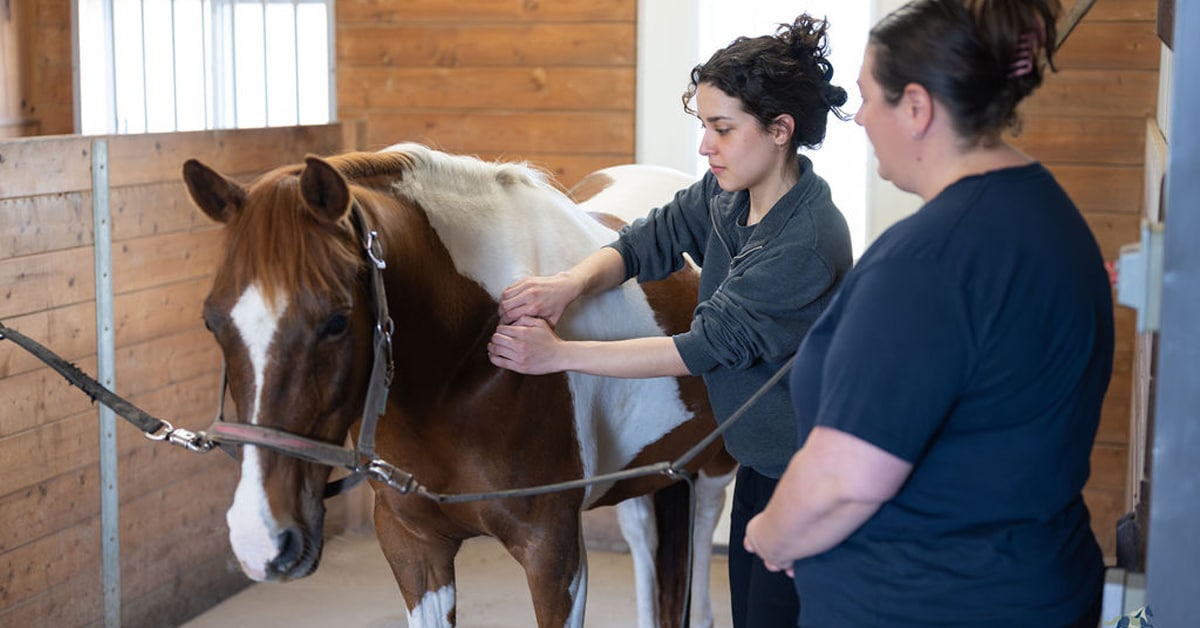Foothills Farm is located in Chelmsford near Sudbury, Ontario, on 500 acres of the beautiful Boreal forest. Equine Canada Level III coach Cathy Inch has trained horses and riders out of Foothills to success on the national circuit in show jumping and hunter-jumper for nearly 40 years. She’s kindly provided some tips for surviving the winter months, gathered from many stretches of -30 °C weather.
Keep Horses Moving
More than anything else, it’s very important to keep horses moving in the winter. During the colder months, conditions like snow, ice and extreme cold often restrict mobility. “The biggest problem is often that the horses do not get to move enough in their paddocks so they have excess energy,” Inch says. “Either the ground is frozen and often full of ruts, or the snow gets deep enough to keep them from moving.”

Cathy Inch. (Spowart Holm Photography)
Riding time also often decreases. “People go back to school or settle into the fall/winter routine they do not ride as often as they do in the summer,” says Inch. “The horses have more down time and are usually much more fresh! Colder weather in general just makes horses more energetic.”
Excess energy can be burned off with continued schooling and in-hand exercise. Lungeing is also a good option. “A lunge before you ride helps to take the edge off. If your arena permits it, give them a loose lunge, boot them well, make sure the ring is safe and let them play a little indoors where the footing is not icy and they can move more.”
Inch also suggests altering your horse’s diet over the winter months to compensate for a decreased workload: “Cut back on their grain; they are not being worked enough anyway.” (More about winter feeding here.)
Use Winter Training Opportunities
Because horses are fresher, work is less intense and weather conditions are worse, winter often comes with increased opportunities for spooking. Unexpected circumstances — like ice sliding off the arena roof — can pose safety issues if riders are unprepared. Inch says the winter weather can serve as an opportunity to desensitize your horse.
“Don’t always avoid chaos. Your horse needs to learn to work in an environment that isn’t always perfect. Don’t be in a hurry, work at the walk and get into those spooky areas, expose them to the ghosts. Let them know it’s not scary, but don’t pick a fight if your horse is fresh or nervous — you will lose! Be authoritative, but patient, or put someone on who can be.”
Inch advises scheduling rides carefully, taking into consideration how fresh horses will be. “Make sure your lessons or jump schools are not after a day off.”
Be Mindful of Footing
Footing conditions are a perpetual worry throughout the winter, whether slippery walkways or hardened paddocks.
There are options for minimizing slipping hazards, such as pulling shoes in the winter months to avoid snow-packed feet. Other options include corks or snow-pads underneath the shoes, but Inch says these come with their own problems.
“Farriers will also recommend snow pads to prevent snow build up and a small set of corks if wearing shoes to help prevent slipping. I am not big on either of these if you are riding indoors, as the corks catch in the footing and can be hard on their joints and the snow pads can be grippy. You can try putting Vaseline on their soles to prevent build up of snow in their shoes.”
(Read other winter hoof care tips here.)
Provide Adequate Shelter
Inch says conditions in Chelmsford make it absolutely necessary for horses to have some kind of protection from the weather during turnout, whether it’s with blanketing or shelters or a combination of the two.
“If you layer up hard to go outside, they should, too. If freezing rain or heavy snow is coming down and your horse is outside for a period of time, then rain sheets are necessary. You do not want them soaking wet in the cold. For horses that live outside, they should have shelters they can go in if miserable weather persists. However, they don’t always go in them, so I feel a blanket is necessary.”
It’s important to inspect blankets closely, especially when conditions are wet. “Blankets must be monitored daily to make sure they are dry and warm underneath. Be sure to have multiple blankets, or a system for getting them dry before the next day’s turnout.”
Equine Guelph has an excellent interactive tool to help you learn about equine thermoregulation, when to blanket, and how to choose the best blanket for your horse here.
Coolers are another necessity for warming up and cooling down in the cold. “I will usually walk horses around in the stable cooler and take it off completely before I trot and start to work,” says Inch.
Dress for the Weather
For riders, Inch advises buying boots that are too big, and then layering two pairs of socks with an insole in them to keep the feet away from the cold stirrup irons. What kind of socks are best? “Wool, wool and more wool is the warmest and breathes the best,” Inch advises.
If you invest in one item for warmth, Inch advises it should be gloves. “Your extremities are always the first to get cold.”
Technology can also be your friend in chilly arenas, but Inch prefers the time-tested way of keeping warm. “Some people buy gloves, socks, vests etc. with heaters in them. I just dress in layers… as I get to work I can always strip down. [Start with] merino wool long underwear and under-top, and layer up from there. Full chaps are also a great idea in the winter. I actually use them year-round.” (Check out more tips to stay snug in the saddle here.)
If All Else Fails…
“Go to Florida!” Inch quips. “You don’t have to be a show rider to enjoy riding in the sunshine.”
The Latest









